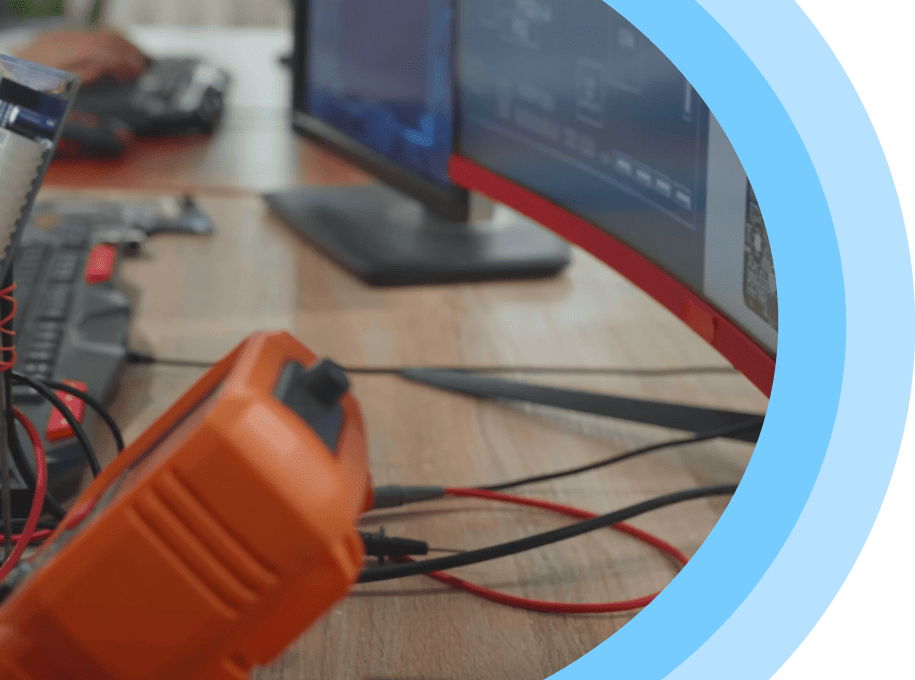New Batch Starts In a Week
Contact us8 months course structured to enable students to gain an in-depth exposure to all the aspects of VLSI design and functional verification using all the industry standard tools including Synopsys VCS & Verdi, Mentor Questasim and Cadence Xcelium.
Next Batch
1-1 Dedicated Mentor Support
24/7 Tool Access
Multiple Mock Interviews
Industry Standard Projects
Support with Resume Update
VLSI Design and Verification Course Overview
Functional verification course for freshers is a 8 months course structured to enable students gain in depth exposure to all the aspects of VLSI design and functional verification. It is one of the exhaustive courses among the courses offered by various institutes
VLSI design and verification course prepares the fresher on all the essential aspects of VLSI front end domain including ASIC flow, advanced digital design, CMOS, SOC design and verification concepts, Verilog, System Verilog, UVM, Linux, version control and scripting. Course also includes training on soft skill for effective interview performance.
Lack of fundamentals in advanced digital design, Analog design and Verilog for design & verification becomes a major deterrent for freshers in finding right career opportunities. VLSI design and verification course offered in both classroom and online mode ensures that fresher is empowered with all the essential skill set required for various job roles in VLSI front end domain. VLSI design and verification course is practical oriented with each aspect of course involving multiple hands on projects. Student progress is tracked using 75 detailed assignments covering all the aspects from digital design, VLSI flow, SOC design & verification, RTL coding, Verilog, System Verilog, RTL debug, UNIX, and PERL/Python scripting.
Advanced Digital Design course focus on all the digital design concepts including combinational logic, sequential logic, circuit design concepts, memory types and other essential things focused in majority of fresher interviews. Course assume minimal exposure to digital design concepts, it starts from basic concepts till advanced concepts including clock domain crossing, synchronisers, timing violation fixing, etc.
Verilog and RTL coding course focus on all Verilog language constructs from practical usage perspective. Training involves 25+ design coding examples focused in fresher interviews.
Systemverilog course gives fresher with required exposure to advanced functional verification concepts. All language constructs are covered with detailed coding examples involving more than 200 examples. Course also offers exposure to standard on-chip communication protocols and verification IP development for AXI. UVM essentials course will emphasis on UVM language constructs and UVC development for AHB Protocol.
RTL debug course will focus on training student with important debug concepts including schematic tracing, RTL tracing, RTL & TB coding issues, etc.
Linux OS course ensures that student gets accustomed to industry work environment. Training also includes exposure to Makefile, revision management and all essential UNIX concepts.
Scripting course will focus PERL essential concepts. It will help student gain exposure to file management, regular expressions, Object oriented PERL, PERL modules and PERL usage in industry. Soft skill training will prepare student on how to face interviews effectively, right body language, etc.
VLSI design and verification course is also targeted for engineers working in non-VLSI domains and planning to make career in VLSI.
Students planning to pursue complex projects after this course can do by paying a nominal fee. Institute offers more than 30+ other projects based on industry standard protocols like USB3.0, PCIe, UFS, SATA, DDR, DMA, AMBA, Bridge and Ethernet MAC etc.
Mentor Graphics, Questasim, Synopsys VCS
- Duration: 30 weeks (8 months)
- Phase#1 – 3 months
- Advanced Digital design
- GVIM text editor, Linux basics commands
- Verilog
- Phase#2 – 2.5 months
- System Verilog
- UVM
- Linux commands – hands on
- Soft skill training – regular weekly sessions
- Candidate gets placement support after 5.5 months of training, i.e after phase#2
- Phase#3 – 2.5 months
- AXI protocol and TB development
- Ethernet MAC core verification using SV & UVM
- Python
- ASIC flow and SOC verification concepts
- RISC-V based SV Verification project
Combinational logic
- Number systems
- Radix conversions
- K-maps, min-terms, max terms
- Logic gates
- Realization of logic gates using mux's and universal gates
- Compliments (1/2/9/10's complement)
- Arithmetic operations using compliments
- Boolean expression minimization, Dmorgan theorems
- POS and SOP
- Conversion and realization
- Adders
- Half adder
- Full adder
- Subtractor
- Half subtractor
- Full subtractor
- Multiplexers
- Realizing bigger Mux's using smaller Mux's
- Implementing Adders and subtractors using Multiplexers
- Decoders and Encoders
- Implementing Decoders and Encoders using Mux and Demux
- Bigger Decoder/Encoder using smaller Decoder/Encoder
- Comparators
- Implementing multi bit Comparators using 1-bit Comparator
Sequential logic
- Latch, Flipflop
- Latch, Flipflop using Gates or Mux's
- Different types of FFs
- FF Truth table
- Excitation tables
- Realization of FF's using other FF's
- Applications of FF's, Latches
- Counters
- Shift registers
- Synchronizers for clock domain crossing
- FSM's
- Mealy, Moore FSM
- Different encoding styles
- Frequency dividers
- Frequency multiplication
- STA
- Setup time, Hold time, timing closure
- fixing setup time and hold time violations
- Launch flop, capture flop
- Verilog language basics
- Verilog : How the language evolved?
- Verilog execution using Modelsim
- Verilog constructs
- Literals
- Data types
- registers, nets
- Vectors, Array
- Operators
- Various styles of Modeling: Data Flow, Behavioral, Gate level, Switch level
- Continuous assignments
- Combinational logic coding : Half adder, full adder, multiplexer, comparator, encoder, decoder, priority encoder
- Generate
- Procedural timing controls
- task and functions
- system task and function
- modeling memories and FSM
- Parameters
- Port connections
- Procedural blocks
- Sensitivity list
- State machines
- timescale
- Verilog timing regions
- process
- Blocking and nonblocking statements
- Inferring combinational and Sequential logic
- Clock generation with Duty cycle & Jitter
- Shift register implementation
- Procedural Blocks
- fork join
- Race conditions
- Synthesis examples
- Inter and Intra delay statements
- example to showcase race condition using blocking assignments
- Pipelining
- Memories
- Structural modeling
- Verilog Programming Interface(& PLI)
- PLI
- compiler directives
- system task usage: $display, $monitor, $strobe
- PLI, VPI implementation
- Primitive implementation using table, endtable
- DFF coding using gate level, behavioral
- Counters
- Up counter
- Ring counter
- Johnson counter
- Memory RTL coding and TB development
- Memory Verilog coding
- Declaring a parameterized memory
- Front door access
- Back door access test case coding
- Implementing task for front door and back door access
- Test case coding and understanding waveforms
- FIFO – Synchronous FIFO and Asynchronous FIFO
- Synchronous FIFO
- Asynchronous FIFO
- Finite state machines
- Mealy and Moore style
- Implicit and Explicit styles of coding
- Pattern detector – Overlapping, Non-Overlapping, Dynamic
- Overlapping
- Non-Overlapping
- Dynamic
- Traffic light controller
- APB protocol
- Interrupt controller
- SPI controller
- CRC generation
- Functional Verification overview
- Test bench architecture
- Test bench components
- Test bench development : Modularity, Reusability
- Understanding Functional Verification flow
- System Verilog Course overview
- System Verilog language features
- Verilog for TB development
- Verilog Language constructs and shortcomings
- operators, data types
- Literals
- Operators - How things change from Verilog
- Data types - Integer based, string
- Arrays
- Arrays
- Array classification
- Packed and Unpacked Arrays
- Static and Dynamic Arrays
- Multi dimensional Arrays
- Dynamic Arrays
- Associative Arrays
- Queue
- Array of Queues in scoreboard implementation, other complex declarations
- Object Oriented Programming
- Basics of OOP – Class, Object, handle
- Class elements – Properties, methods, constraints
- Properties – 5 attributes in property declaration – rand/randc, signed, static, 2/4 state, data hiding
- Language provided and User defined methods
- Developing Ethernet frame and APB Tx class
- new constructor
- randomize, pre_randomize, post_randomize
- User defined methods – print, copy, compare, pack, unpack
- Encapsulation – Data hiding, local, protected, public
- Inheritance
- Ethernet frame generation example to learn OOP
- Polymorphism – real life usecases
- this, super
- Class forward declaration
- Multiple levels of inheritance
- Abstract class
- Parameterized classes
- Difference from Verilog parameterization
- Parameterization with inheritance – 4 combinations
- Parameterized classes for testbench development
- Static properties and methods
- Interface class
- Constant class property
- Scope resolution operator
- Nested class
- Variable scope
- Object copying – copy by handle, shallow copy, deep copy
- $cast – static and dynamic casting
- Advanced Data types
- Data types – Chandle, event, typedef, struct, union, enum
- Using struct data type for medals tally sorting example
- Typedef for defining complex data types
- Using complex data types in scoreboard development
- Fork join, Inter process synchronization
- Labeling
- Fork join – join_any, join, join_none
- Nested fork
- Labeling fork
- Process, process states
- Inter process synchronization
- IPS constructs – mailbox, event, Semaphore
- mailbox – types, methods
- events – persistant, synchronization examples
- Semaphore – synchronization examples
- Project to learn all SV language constructs
- Project – Memory TB development covering 90% of SV language constructs
- Configurable memory TB development
- Interface – Ports, internal signals, clocking block, modport
- using clocking block to fix design - TB synchronization issues
- Physical interface, virtual interface
- Using interface for design and TB connection
- Program
- Program significance
- How Program differs from Module
- Why Program is redundant?
- Scheduling semantics
- Scheduling semantics
- Task, Function
- Task, function – how they are different from Verilog
- Static & automatic task/functions
- System task and functions
- Constraints, Randomization
- Constraints format
- Constraints type – Simple, distribution, implication, if-else, iterative, variable ordering, soft, unique
- Inline constraints
- Constraints for queue randomization
- Constraints virtual nature
- Randomization
- randcase
- Randomization in class, module
- rand, randc
- Constrained random verification
- Directed verification
- Multiple hands on examples on Constraints and Randomization
- Chip select example using multiple inter related constraints
- new significance for randc
- Functional and code coverage
- Functional Coverage
- What is functional coverage?
- Need for functional coverage
- Where FC comes in functional verification flow?
- How to implement FC?
- Different types of FC?
- Integrating Functional coverage in Test bench
- functional coverage hierarchy
- Different types of coverpoints – simple, cross, transition
- Different types of bins – normal, illegal, ignore
- coverage calculation
- coverage options – auto_bin_max, weight, at_least, goal, comment, name, per_instance, detect_overlap
- Listing down cover points for a design
- Instance coverage
- Cross coverage with intersect
- FC system task & Functions
- Coverage Driven Verification
- Coverage report analysis
- Cover groups with arguments
- Coverage filter using iff
- Functional coverage types in TB – transaction class coverage, register field coverage, scenario coverage
- Code coverage
- Generating code coverage
- Different types of code coverage – FSM, Conditional, Branch, Expression, Statement, Toggle
- Detailed understanding of code coverage types with examples
- Merging UCDBs, generating coverage reports
- Analyzing coverage report
- Coverage exclusion
- Assertions and Assertion based verification
- Need for assertions?
- Assertion based verification
- Types of assertions
- Immediate assertions
- Concurrent assertions
- Assertion format – antecedent, consequent
- Running assertions using questasim, debugging the assertions in waveform
- Assertion hierarchy – property, sequence, boolean expression
- ##, |-> and |=> operators
- Assertion examples for clock frequency check
- Assertion with local variables
- Assertions for simple timing diagrams
- Listing down and implementing assertions for simple designs – Async FIFO, Interrupt controller
- DPI
- Direct Programming Interface(DPI)
- import and export of functions
- Configuration libraries, Packages, XMR
- Configuration Libraries
- Incremental compilation
- Packages – defining, importing
- XMR
- Configuration libraries, Packages, XMR
- Compiler directives & Macros
- Parameterizable macros
- VCD – value change dump
- common array methods
- Callbacks – multiple use case examples
- What is UVM? Need for a methodology?
- How UVM evolved?
- OVM, AVM, RVM, NVM, eRM
- UVM class library
- Classification of base classes in various categories
- OOP basics
- Encapsulation
- Inheritance
- Polymorphism
- Parameterized classes
- Parameterized macros
- Static properties and static methods
- Abstract classes
- Pure virtual methods
- How above aspect correlates with UVM implementation.
- UVM Class Library, Macros, Utilities
- Detailed overview of important UVM base classes, Macros and Utility classes.
- UVM TB Architecture
- Setting up a UVM based testbench for APB protocol from scratch.
- Significance of uvm_root in UVM based testbenches.
- run_test, how it starts whole TB flow.
- Command line processor
- Reporting classes
- Uvm_report_object
- Uvm_report_handler
- Uvm_report_server
- Detailed examples on use of methods in these classes.
- Objections
- UVM Factory
- Configuration DB, Resource DB
- Detailed usage of both data bases.
- How config_db is related to resource_db?
- Using config_db to change the testbench architecture.
- TLM1.0
- Push
- Pull
- FIFO
- Analysis
- Complex example on AHB to AXI transaction conversion.
- Simulation Phases
- UVM common phases
- Scheduled phases
- Sequences, Sequencers
- Default sequence
- p_sequencer
- m_sequencer
- Test case development
- Different styles of mapping testcase to sequence
- Using default sequence and scheduled phases
- Using sequence start method
- Configuring TB Environment
- Advanced aspects of developing a highly configurable test bench environment.
- Concept of knobs of test case scenario generation
- Using top level parameters to control the overall TB architecture
- Different testbench component coding
- Monitor
- Coverage
- Scoreboard
- Checkers
- Assertions
- Different styles of sequence development
- `uvm_do
- start_item and finish_item
- Using existing sequences
- Sequence library
- Creating complex test cases using sequence library
- Virtual Sequencer, Virtual sequences
- Installing Linux platform in Windows
- Linux basics
- Linux versus Windows
- Linux Terminal
- File and Directory management
- Changing file permissions
- Absolute path and relative path
- Working with directories
- GVIM – major keyboard shortcuts
- Text display commands
- Root configuration files
- Environment variables
- Text processing commands
- grep, fgrep
- xargs
- SEd
- AWK
- Pipes and filters
- Connecting to server
- Process management
- LSF
- Ping
- FTP
- CTAGs
- File compress and extract
- Soft links
- Protocol basics
- Protocol overview
- Protocol features
- AMBA protocol overview
- AXI Protocol basics
- SOC Architecture – Significance of AXI protocol
- AXI based system architecture
- Correlating AXI with APB protocol
- Ports(signals) required for AXI protocol
- AXI Channels
- Write & Read Channels
- Handshaking using valid and ready
- Write Channel Signals – Address, Data and Response
- Read Channel Signals – Address and Data
- Timing diagrams
- How to draw the timing diagrams?
- Write Transaction Timing Diagram
- Read Transaction Timing Diagram
- AXI transaction analysis for big endian and little endian architecture
- Wrap transactions – write and read
- Narrow transfers
- Data bus and strobe relation
- Aligned and unaligned transfers
- AXI signal encoding
- Responses in AXI
- Locked and exclusive transfers
- Overlapping, out of order, interleaved txs
- Interconnect role in out of order transaction
- Significance of ID in AXI protocol
- AXI Channel handshake dependency
- Cacheable and bufferable transactions
- Protected transactions
- AXI VIP and UVC development
- Need for UVC?
- Different types of UVC's
- UVC usage in module and SOC verification
- Where Passive UVC are used?
- UVC integration in to TB
- AXI UVC architecture
- AXI Transaction Definition
- AXI UVC coding
- AXI TB simulation and wave form analysis
- AXI UVC integration
- AXI scoreboard coding
- SoC Verification Concepts
- Module Level Verification
- Constrained Random Verification
- Coverage Driven Verification
- Directed Verification
- Assertion Based Verification
- Reading design specification
- How to read specification – understanding architecture, sub blocks, interfaces, registers
- Listing down features, scenarios
- Develop testplan
- Functional coverage point list down
- Develop Testbench architecture
- Testbench component coding and integration
- Develop sanity testcases(smoke tests)
- Bring up test bench environment using sanity testcases
- Develop rest of test bench components including monitor, coverage and scoreboard
- Register model(RAL) development and integration
- Register write-read, reset tests using front door and back door access
- Functional testcase coding using Register model
- Functional testcase debug using RTL, data flow and schematic tracing
- Setup regression using Python
- Debug regression failures
- Functional, Code and assertion coverage analysis
- Develop more functional tests for coverage improvement
- Schematic tracing
- RTL tracing
- Fixing RTL and TB syntax and logical errors
- SOC Architecture overview
- SOC verification concepts
- SOC Components
- SOC use cases
- SOC Testbench architecture
- SOC verification differences with module verification
- Specification
- RTL coding, lint checks
- RTL integration
- Connectivity checks
- Functional Verification
- Synthesis & STA
- Gate level simulations
- Power aware simulations
- Placement and Routing
- DFT
- Custom layout
- Post silicon validation
- Python Interpreter
- Variables
- File management
- Subroutines
- Regular expressions
- Object oriented Python
- Python modules
- Facing interviews effectively
- industry work culture
- Group discussions
100+ detailed assignments covering all aspects from Verilog, Advanced digital design, System verilog, UVM, AXI protocol, VIP Development, Ethernet MAC core verification, RTL debug, UNIX and PERL scripting.

Key Features
Who All Can Attend This VLSI Design and Verification Course?
This course is designed for individuals aspiring to build or enhance a career in semiconductor design and verification. Whether you're just starting out or transitioning from related domains, it equips you with industry-relevant skills and tools.Pre-requisites To Take VLSI Design and Verification Course
- No Pre-requisites, as the course covers all aspects from scratch.
High Demand for VLSI Design and Verification Course
Know about the Growing VLSI industry
This is a crucial role focused on ensuring that the integrated circuit (IC) design works correctly before manufacturing. You'll be involved in creating test plans, developing test environments using languages like SystemVerilog and methodologies like UVM, running simulations, and finding and fixing design bugs. This role requires strong analytical and problem-solving skills, as well as a keen eye for detail. You'll work closely with the design engineers throughout the process.
₹4 LPA
₹6.5 LPA
₹7.5 LPA
₹9.5 LPA
₹11.5


- Customized training programs for teams
- Upskill and reskill employees with industry-relevant content
- Interactive sessions led by expert trainers
- Hands-on projects and real-world case studies
- Flexible delivery in online
- Improve productivity and efficiency
- Access to training resources and material

- Learn in real-time with instructor-led sessions
- Flexible access from anywhere
- Recorded sessions available for revision
- Training on industry-standard tools
- Get certification after completion

- Self-paced learning as per your flexibility
- Industry-aligned learning modules
- Certification after course completion
- Access to structured video lessons and materials
- Track your progress step by step
- Access to learning materials for more than 1.5 years
For fresh graduates, the VLSI Design and Verification course serves as a direct gateway into one of the most in-demand and innovation-driven sectors of the tech industry. With semiconductor and chip design playing a central role in devices ranging from smartphones to electric vehicles, this course provides essential technical grounding in RTL design, verification methodologies, and tools like Verilog, SystemVerilog, and UVM. It bridges the gap between academic knowledge and real-world applications, enabling a smooth transition into core VLSI roles and making candidates industry-ready from day one.
Career Path
Learning Path

At VLSIGuru, we believe that education should lead to meaningful employment. Our training programs are designed not just to impart technical excellence, but also to bridge the gap between academic learning and industry demands. With a strong network of hiring partners and a proven track record, we ensure that our students are career-ready.
Placement Highlights
- Industry-aligned curriculum
- Hands-on projects and case studies
- Communication skills
- Resume building and interview preparation
- Technical and HR mock sessions
- Aptitude and domain-specific test series
- Regular drives and exclusive hiring events with partner companies
- Resume building and interview preparation

At VLSIGURU, we provide industry-focused VLSI training and guidance that helps students and professionals build strong technical skills and succeed in their careers. Our programs are designed to be practical, flexible, and aligned with current industry requirements.
Student Reviews
Preethi
Preethi




Frequently Asked Questions
- Course presentations for all topics
- Session notes
- Lab documents with detailed steps
- User guides
No pre-requisites. Good to know C language & exposure to Digital Design concepts
- Each aspect of course is supported by lot of practical examples
- Dedicated full day lab sessions to ensure student does complete testbench development from scratch
- Yes, You will have option to view the recorded videos of course for the sessions missed
- You will have option to repeat the course any time in next 1 year
- Yes, the Course fee also includes support for doubt clarification sessions even after course completion
- You have the option to mail your queries
- Option to meet in person to clarify doubts
Yes, VLSI is a highly rewarding career with global demand. As electronic devices become more advanced, the need for skilled chip designers and verification engineers continues to grow, offering attractive salaries and job stability.
Yes, VLSI involves hardware description languages like Verilog, VHDL, and SystemVerilog for design and verification. Basic programming concepts and logical thinking are important.
To become a verification engineer, you should learn digital design fundamentals, SystemVerilog, UVM methodology, and simulation tools. Enrolling in a VLSI verification course can provide hands-on experience and placement support.
Entry-level VLSI verification engineers in India typically earn between ₹4 to ₹8 LPA, depending on skills, location, and company. With experience, salaries can significantly increase, especially in product-based firms.
Yes, at VLSI Guru, we offer both online and offline VLSI courses, making it convenient for working professionals and students to learn from anywhere.
Yes, VLSI Guru provides dedicated placement support, including mock interviews, resume building, and access to hiring partners in the VLSI industry.
VLSI Guru offers specialized programs in front-end VLSI design, RTL coding, functional verification using SystemVerilog/UVM, and more. Both short-term and long-term programs are available.
You’ll learn Verilog, SystemVerilog, and scripting languages like Tcl and Python. These are essential for design, verification, and automation tasks.
Students get hands-on experience with industry-standard tools like ModelSim, QuestaSim, Xilinx Vivado, Synopsys VCS, and Cadence tools.
You can work as a Design Engineer, Verification Engineer, RTL Engineer, Physical Design Engineer, DFT Engineer, or Application Engineer, depending on your training and interests.
VLSI Guru’s trainers are industry professionals and VLSI experts with years of hands-on experience. They are selected based on technical proficiency, industry exposure, and teaching aptitude.
You’ll work on real-world projects such as ALU design, UART protocol implementation, FSM-based control logic, testbenches using UVM, and SoC verification setups.
By offering project-based learning, exposure to real tools, mock interviews, mentorship, and continuous assessment, VLSI Guru ensures students are industry-ready by the end.
You can enroll by visiting the VLSIGuru website, filling out the inquiry form, or contacting the admissions team directly for counseling and course guidance.
On successful completion, you will receive a VLSIGuru course completion certificate, and in some programs, additional certification based on partner tools or industry collaborations.
Are you looking to build a rewarding career in the semiconductor industry? Enroll in a comprehensive VLSI Design and Verification course for freshers and unlock exciting job opportunities in one of the most in-demand tech domains. Whether you're a recent graduate or just starting your journey in electronics, the right course can lay the foundation for your success.
For those new to the field, choosing a VLSI Design and Verification course for beginners is essential. These programs are tailored to cover both theoretical and practical aspects, including digital design, Verilog, SystemVerilog, RTL coding, and verification methodologies like UVM. With hands-on labs and real-world projects, beginners gain confidence and skills to excel in interviews and on-the-job tasks.
Finding the right VLSI design training institute is key to mastering the core concepts and tools used in the industry. Look for an institute that offers expert faculty, industry-relevant curriculum, placement assistance, and access to simulation tools and EDA software. A well-structured training program ensures you understand every stage of the VLSI design and verification flow, from specification to tape-out.
In addition to technical training, top institutes also offer soft skill development, mock interviews, and resume-building workshops to prepare students for the job market. The goal is to bridge the gap between academic knowledge and industry expectations. Some training institutes even have tie-ups with leading semiconductor companies, increasing your chances of placement.
You can also consider flexible VLSI design classes if you are balancing studies or work. Many institutes offer both online and offline options, weekend batches, and recorded sessions for better convenience and accessibility.
In summary, whether you're a fresher or a beginner, choosing the right VLSI Design and Verification course from a reputed VLSI design training institute can significantly boost your career prospects. With the right guidance and training, you can become a skilled VLSI engineer ready to take on challenging roles in ASIC/FPGA design, verification, or physical design.
Take the first step today—enroll in top-rated VLSI design classes and start your journey toward a high-growth career in VLSI!


